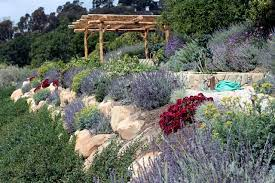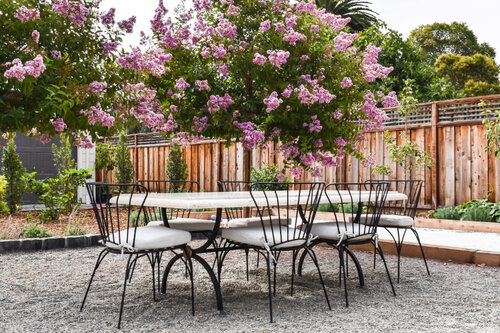It's now time to unveil the garden with a Mediterranean theme that has been in the works for so long! a bocce court, lavender, succulents, crape myrtles, natural stone pavers, and a lot of pea gravel are all included. (Lots!)
It's my outdoor haven, and I like it, especially after enduring the miserable conditions in the garden for so long (like, 12 years).
There are affiliate links in this article. To view my entire disclosure, click here.]
Check out The initial Step In Designing A Garden, my initial post on the project, if you're interested in learning more about how I create landscapes. See the detailed landscape plans below by continuing to read.
A bird's eye perspective is shown below. I drew heavily from historical references to gardens, including those at the Moorish Alhambra in Spain as well as those in Southern France, Italy, and Portugal.
The garden's layout is largely symmetrical, as you can see. I positioned it to correspond with the view from the interior kitchen sink, where I frequently spend time.
The bocce court, patio, and main kitchen window are all divided by an invisible midline.
There is no concrete used everywhere; only pea gravel. This enables versatile usage of the space
[Looking for more design ideas and practical plant advice? Let's chat on Instagram together!
Let's begin with some Before pictures. There was a lot of crumbling concrete on the driveway, some grass, and a lot of overgrown foliage in the "before" picture. The disorganised collection of plants had been neglected for a very long period.
I had a clear concept of what I wanted after so many years of mentally remodelling while longingly staring out of my kitchen window. I had a rough plan and detailed suggestions for how to create a stunning garden that was also useful and affordable in my brain.
Design Restrictions
Constraints in design are exactly what they sound like; obstacles you must overcome. You may need to work around constraints imposed by city ordinances, financial constraints, or preexisting features.
I've always maintained that projects with design restrictions are superior to initiatives with carte blanche because they force you to be creative. The outcome is frequently improved as a result.
[Read more about this in my piece How To Design A Room, my "design manifesto" (ha)].
Here are my key limitations for designing the landscape:
The basement of my property occasionally floods due to water permeability (for example, when the sump pump fails at 11:00 PM on a work night).
I desired a surface that could allow water to percolate through it. Since water from a permeable surface replenishes the aquifer instead of draining into a storm drain, it is beneficial for the environment.
It lessens floods as well. Compared to agricultural or rural land, urban areas might be up to 90% more susceptible to flooding.
Why? due to the paving of metropolitan areas. This indicates that instead of being absorbed by the ground, water sits on the surface with nowhere to go.
Budget
I made and followed a budget. I decided to drop the east and north property improvements from the project scope for the time being, along with a stucco wall and security gate.
This process of project "phasing" is known. Plan the complete project, but install it in stages as the money or the situation permits. By doing this, you can prevent having a piecemeal design.
[Learn all about creating a remodelling project budget.]
Garden Design Priorities
I'll stop here with the introduction and give you my list of project priorities and their outcomes.
Pea gravel is lovely, permeable, inexpensive, and indestructible.
The same applies to natural stone pavers. Beautiful and unbreakable; not mortared, but placed in sand.
Natural, planted-instead-of-built shade structure.
Bocce court in Napa is enjoyable and adds value.
drought-tolerant and adapted to the arid state of California are Mediterranean plantings.
Plant colour scheme: mostly green, white, lavender, and pink.
Pea Gravel “Hardscape”
Two of the most typical surfaces utilised in traditional Mediterranean-style gardens are pea gravel and decomposed granite. You will find many of them (and no turf grass) if you study gardens in Spain, France, Italy, and other countries.
Why? It was a material that was simple to find. acres of water-hungry lawns and acres of concrete? Nope. They too had to practise water conservation.
Traditional gardens are a great source of design inspiration. I would have spent a lot more money and been far less pleased with the outcome if I had chosen concrete.
Since the driveway, parking, and patio are all made of pea gravel, there is no differentiation between them. It no longer feels like you're hanging out in a driveway when I put up tables and enjoy wine in the "driveway" for a party thanks to this.
Metal edging
The best piece of advise I can give is to budget a little bit extra for metal edging over plastic bender board. The final appearance is incomparable. The bender board leaps out as the metal edging vanishes. (See the photo below)
Stone Pavers
Silver travertine makes up the new walkway and stair into the kitchen's back area. I fell in love when it was utilised on a house in the neighbourhood for their patio and pool.
The majority of travertine's beige colour has never really appealed to me, but this warm silvery shade completely changes my opinion.
Silver travertine appealed to me as a practical option because I wanted a lighter-colored stone but was concerned that it would stain. This stone is quite "busy" with its various colours and inherent flaws, but thus far, everything that has fallen to the ground on it, from fruit to bird droppings, has vanished.
Instead of using mortar, I had the pavers laid in sand. Real possibilities include ground water, earthquakes, and teenage males running over and damaging my beautiful pavers.
I preferred that the pavers move somewhat rather than break, and I wanted to be able to quickly remove and replace a stone if necessary.
I combined a dark granite block and aluminium edging for the planter borders. Pea gravel and the dark grey granite combine nicely. Silver granite pebbles laid in sand form the border at the entrance to the driveway and in front of the garage.
The planter border's dark grey and the cobbles' brighter silver weren't what I had in mind. I was initially really concerned about it, but it turned out to be the result of a purchasing mix-up. But like so many other things, I now take it for granted, and they go well together.
I didn't want to construct a shade structure since I rarely find them to be attractive, they're expensive, and frequently they don't last well.
Is that "natural shade structures" only catch? They demand endurance! I spent more money on 36" box crape myrtle trees, but they won't provide enough shade for a while.
In fact, this season I finally caved and purchased two shade umbrellas. They have a nice appearance, but Napa has had such a windy year that they frequently blow over while open.
I've turned to more fertilising and watering to promote future shade more quickly!
Here is my outdoor dining travertine table from Ebay, surrounded by 'Muskogee' crape myrtles.
Bocce Court
Bocce courts aren't that expensive when compared to a whole landscape redesign. I'm from Napa, California, also known as Wine Country, so they add value when they're expertly made and kept.
In terms of available space, it may also be essentially replaced by a single-lane indoor pool. (Not financially!)
Drought Tolerant Plants
Although plants adapted to California are sometimes referred to as Mediterranean, similar climates can also be found in sections of Australia, South Africa, and Chile. Summers there are hot and dry, and winters there are chilly and rainy.
Fortunately, this means we have a wide selection of lovely and intriguing flora. I feel like a kid in a candy store when it's time to make a planting plan!
















![How To Waterproof Your Plant Pots [5 Minute DIY]](https://blogger.googleusercontent.com/img/a/AVvXsEgH9Y9bMy5i1jeEXDVjrNritwSFcwnlvkV9bcBcsYZp8aLZUTesr0H1RAhYd3J3Em9ZVUIPmg8oyXFZ_Kjj0rwj6sG7n56kS75WWIX5vD32U6eIRgciFa02CnsovgXyidPktHlhcjMa7rJb0wZlvZpiovKsjPxGr60IZSHgbIKQKZdQivzJbcffRsjtMw=s72-c)


No comments:
Post a Comment